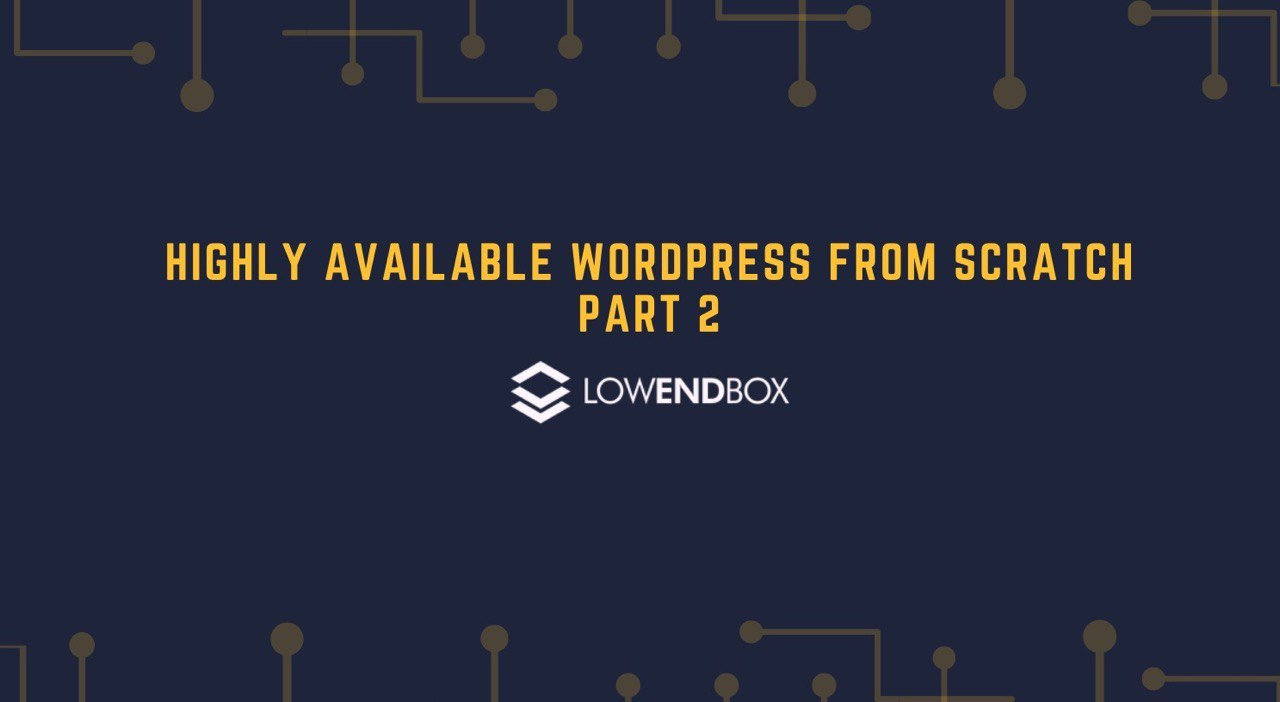 In this tutorial series, we are setting up a highly available WordPress web site from scratch.
In this tutorial series, we are setting up a highly available WordPress web site from scratch.
Part 1 – Introduction, Considerations, and Architecture
Part 2 – Setting Up the VPSes
Part 3 – Setting Up MariaDB Multi-Master Replication
Part 4 – File Replication and Setting Up DRBD
Part 5 – Setting Up OCFS2
Part 6 – Round-Robin DNS, Let’s Encrypt, & Conclusion
Setting Up the VPSes
Here is our setup:
- web1.lowend.party and web2.lowend.party are the two nodes, both running Debian 10 x64.
- www.lowend.party will be the URL that is highly available.
- We’re using WordPress 5 running on MariaDB. Since this is a tutorial on HA and not on web design, we’re just going to use the stock WP theme and not spend much time on prettifying the site.
- In this tutorial, I will use 1.1.1.1 to represent web1.lowend.party’s IP, and 2.2.2.2 to represent web2.lowend.party’s IP.
Here is a checklist of what was done to setup the web sites. This was done on both nodes. Note that there are many other things one should do for a production site – setup an active firewall, setup backups, configuring mail, etc. But this is just a tutorial focused on HA WordPress.
DNS is not listed as we’ll cover that in more detail.
The checklist:
- provisioned the VPSes (with embedded ssh key for root)
- dpkg-reconfigure locales (or use locale-gen)
- dpkg-reconfigure tzdata (to set my preferred timezone, or you can use timedatectl)
- set hostname in /etc/hostname (a Linode-ism)
- apt-get update && apt-get -y upgrade
- apt-get install nginx mariadb-server php-fpm php-mysql
- ran mysql_secure_installation
Database Setup
I created a database and user for WordPress on both nodes:
# mysql MariaDB [(none)]> create database wp; Query OK, 1 row affected (0.000 sec) MariaDB [(none)]> create user 'wp'@'localhost' identified by 'complexpassword'; Query OK, 0 rows affected (0.001 sec) MariaDB [(none)]> grant all on wp.* to 'wp'@'localhost'; Query OK, 0 rows affected (0.000 sec) MariaDB [(none)]> flush privileges; Query OK, 0 rows affected (0.000 sec)
Web Site (nginx) Configuration
I created /web/www.lowend.party as my web root created appropriate log files in /var/log/nginx and set /etc/logrotate.d to handle them:
# mkdir -p /web/www.lowend.party # mkdir -p /var/log/nginx/www.lowend.party # chown www-data:adm /var/log/nginx/www.lowend.party/ # cp /etc/logrotate.d/nginx /etc/logrotate.d/nginx_web_dirs # sed -i 's#nginx/\*.log#nginx/\*/\*.log#' /etc/nginx/nginx_web_dirs
That last sed command changes “/var/log/nginx/*.log” to “/var/log/nginx/*/*.log” so the per-domain logs in /var/log/nginx/www.lowend.party are rotated.
Next I setup the nginx config as follows. This is using php-fpm for php support. Here is /etc/nginx/sites-available/www.lowend.party:
server { server_name www.lowend.party; access_log /var/log/nginx/www.lowend.party/access.log; error_log /var/log/nginx/www.lowend.party/error.log; location ~ \.php$ { fastcgi_split_path_info ^(.+\.php)(.*)$; include /etc/nginx/fastcgi_params; fastcgi_pass unix:/run/php/php7.3-fpm.sock; fastcgi_index index.php; fastcgi_param SCRIPT_FILENAME /web/www.lowend.party$fastcgi_script_name; } location / { root /web/www.lowend.party; index index.php index.html; try_files $uri $uri/ /index.php; if (!-e $request_filename) { rewrite . /index.php last; } } }
Note that we’re not doing https yet. Fear not – we will get there but not until we’ve got DRBD up and running.
Finally I brought the site up:
# ln -s /etc/nginx/sites-available/www.lowend.party /etc/nginx/sites-enabled/www.lowend.party # systemctl restart nginx
Setting up WordPress on web1
Setting up WordPress itself is quite simple, but how to get it up and running when we haven’t created the www.lowend.party record yet? The easiest way was to manipulate my local PC’s hosts file to override DNS
On Windows this would be c:\windows\system32\drivers\etc\hosts while on Mac or Linux it’s /etc/hosts. I created this temporary entry:
1.1.1.1 www.lowend.partyThen ran the WordPress installer. It’s just answering questions but if you need a guide, one is available from wordpress.org. https://wordpress.org/support/article/how-to-install-wordpress/
In the words of Bon Jovi, whoa-oh, we’re halfway there. WP is up and running on one node. What about the next one?
Setting up WordPress on web2
There’s no need to setup everything on web2 manually. They’re both the same distro running the same software.
Copy over the web directory. On node1:
scp -rp /web web2.lowend.party:/Copy over the nginx site definition:
scp /etc/nginx/sites-available/www.lowend.party web2.lowend.party:/etc/nginx/sites-availableSetup logging on web2:
# mkdir -p /var/log/nginx/www.lowend.party # chown www-data:adm /var/log/nginx/www.lowend.party/ # cp /etc/logrotate.d/nginx /etc/logrotate.d/nginx_web_dirs # sed -i 's#nginx/\*.log#nginx/\*/\*.log#' /etc/nginx/nginx_web_dirs
Make the site live on web2:
# ln -s /etc/nginx/sites-available/www.lowend.party /etc/nginx/sites-enabled/www.lowend.party # systemctl restart nginx
Copying the MySQL Database
On web1, backup the WordPress database using mysqldump:
mysqldump wp > /tmp/wp.sqlCreate the WordPress database and user on web2:
MariaDB [(none)]> create database wp; Query OK, 1 row affected (0.000 sec) MariaDB [(none)]> create user 'wp'@'localhost' identified by 'complexpassword'; Query OK, 0 rows affected (0.001 sec) MariaDB [(none)]> grant all on wp.* to 'wp'@'localhost'; Query OK, 0 rows affected (0.000 sec) MariaDB [(none)]> flush privileges; Query OK, 0 rows affected (0.000 sec)
Now restore the wp database:
# mysql wp < /tmp/wp.sqlI then changed my local hosts file to point at web2, and the site looks identical to how it will appear on web1.
At this point, we have WordPress up and running on two sites. If this was a static site, we’d be done. But because we’re using WordPress, we need to make both the database and web filesystem (where themes, uploads, etc. are stored) synchronized.
Next Part: Part 3 – Setting Up MariaDB Multi-Master Replication





















2020-2024 and still no continue?
We will fix the links at the top of this article right now. Sorry for the trouble.
Please refresh and you will see the links to all Parts to this article series now.